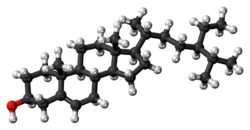Beta-Sitosterol
 |
|
 |
|
| Names | |
|---|---|
|
IUPAC name
17-(5-Ethyl-6-methylheptan-2-yl)-10,13-dimethyl-2,3,4,7,8,9,11,12,14,15,16,17-dodecahydro-1H-cyclopenta[a]phenanthren-3-ol
|
|
| Other names
22,23-Dihydrostigmasterol, Stigmast-5-en-3-ol, β-Sitosterin
|
|
| Identifiers | |
|
83-46-5 |
|
| 3D model (Jmol) | Interactive image |
| ChEBI |
CHEBI:27693 |
| ChEMBL |
ChEMBL221542 |
| ChemSpider |
192962 |
| ECHA InfoCard | 100.001.346 |
| PubChem | 222284 |
| UNII |
S347WMO6M4 |
|
|
|
|
| Properties | |
| C29H50O | |
| Molar mass | 414.72 g·mol−1 |
| Melting point | 136 to 140 °C (277 to 284 °F; 409 to 413 K) |
|
Except where otherwise noted, data are given for materials in their standard state (at 25 °C [77 °F], 100 kPa).
|
|
|
|
|
| Infobox references | |
β-Sitosterol (beta-sitosterol) is one of several phytosterols (plant sterols) with chemical structures similar to that of cholesterol. Sitosterols are white, waxy powders with a characteristic odor. They are hydrophobic and soluble in alcohols.
Beta-sitosterol is widely distributed in the plant kingdom and found in vegetable oil, nuts, avocados and prepared foods, such as salad dressings.
β-sitosterol is being studied for its potential to reduce benign prostatic hyperplasia (BPH) and blood cholesterol levels.
High levels of β-sitosterol concentrations in blood have been correlated with increased severity of heart disease in men having previously suffered from heart attacks.
While plant sterols are usually beneficial, there is a rare autosomal recessive genetic disorder phytosterolemia which causes over-absorption of phytosterols.
Being a steroid, β-sitosterol is precursor of anabolic steroid boldenone. Boldenone undecylenate is commonly used in veterinary medicine to induce growth in cattle but it is also one of the most commonly abused anabolic steroids in sports. This led to suspicion that some athletes testing positive on boldenone undecylenate didn't actually abuse the hormone itself but consumed food rich in β-sitosterol.
The use of sitosterol as a chemical intermediate was for many years limited due to the lack of a chemical point of attack on the side-chain that would permit its removal. Extensive efforts on the part of many laboratories eventually led to the discovery of a pseudomonas microbe that efficiently effected that transformation. Fermentation digests the entire aliphatic side-chain at carbon 17 to afford a mixture of 17-keto products including dehydroepiandrosterone.
...
Wikipedia
